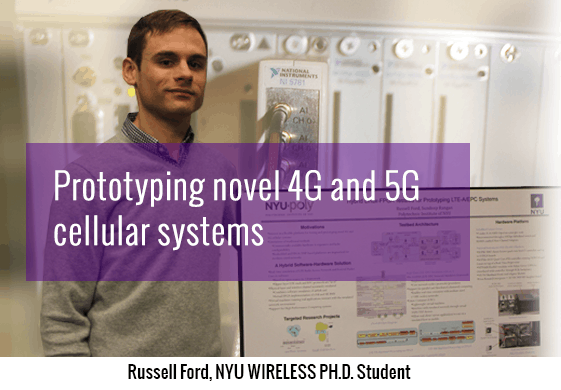Testing And Prototyping Novel 4G And 5G Cellular Systems

In the fast-paced world of wireless technology, researchers need a powerful and flexible platform to rapidly design and prototype communications systems and protocols at all layers of the protocol stack. Traditional test solutions, such as commercially available channel and base station emulators, are often prohibitively expensive and lack the programmability and flexibility needed when engineering completely new technologies. Offering a more configurable alternative to “big box” equipment, individual embedded microcontroller, FPGA, and DSP boards typically found in academic labs leave much to be desired, and are often impractical for experimenting with networks larger than just a few nodes. This is why NYU WIRELESS graduate student Russell Ford, under the supervision of Prof. Sundeep Rangan, is building a testbed that combines the benefits of FPGA Software-Defined Radio (SDR) with real-time, software-based network emulation.
The researchers believe the new flexible real-time emulation environment will dramatically decrease turnaround time for designs and algorithm testing for future millimeter-wave cellular networks that exploit cooperative communication and high gain steerable antennas. The emulation system works hand in hand with a real time channel model that may be implemented using real-world millimeter wave (mm-wave) propagation data from New York City collected by the research team of Prof. Ted Rappaport. The ability to implement and evaluate a wide range of new approaches will accelerate and differentiate the activities at NYU WIRELESS, in the fields of cellular and wireless networking.
The testbed makes use of the popular, open-source NS-3 framework to simulate medium-size LTE/EPC networks in real-time on a multi-core Linux machine. One of the advantages of NS-3 emulation is the ability for real applications to tap into the simulation using virtual network interfaces. Sponsored by National Instruments and Interdigital Communications, corporate members of the NYU WIRELESS Industrial Affiliates program, with funding from the National Science Foundation (NSF), the new simulation capabilities are helping drive product development for future products at the participating companies.
The emulation environment causes the application layer to appear as if it were running on a device, such as a laptop or smartphone connected to the simulated network. This enables the testing of applications like video and voice in their own native operating system on top of an entirely virtual wireless network.
Ford, a Ph.D. student in Electrical and Computer Engineering, co-ops at National Instruments in Austin, Texas when he is not working on his Ph.D. at NYU. He believes that the testbed will be an invaluable tool for research, not only for improving current systems like LTE but also for investigating novel, next-gen systems such as mm-wave cellular. By combining the speed and accuracy of FPGAs with the ease of programming software simulation into a single platform, researchers can undertake these kinds of challenging systems engineering projects that would be considerably more difficult using traditional solutions.

 2025 Brooklyn 6G Summit — November 5-7
2025 Brooklyn 6G Summit — November 5-7 Sundeep Rangan & Team Receive NTIA Award
Sundeep Rangan & Team Receive NTIA Award 2025 Open House
2025 Open House








